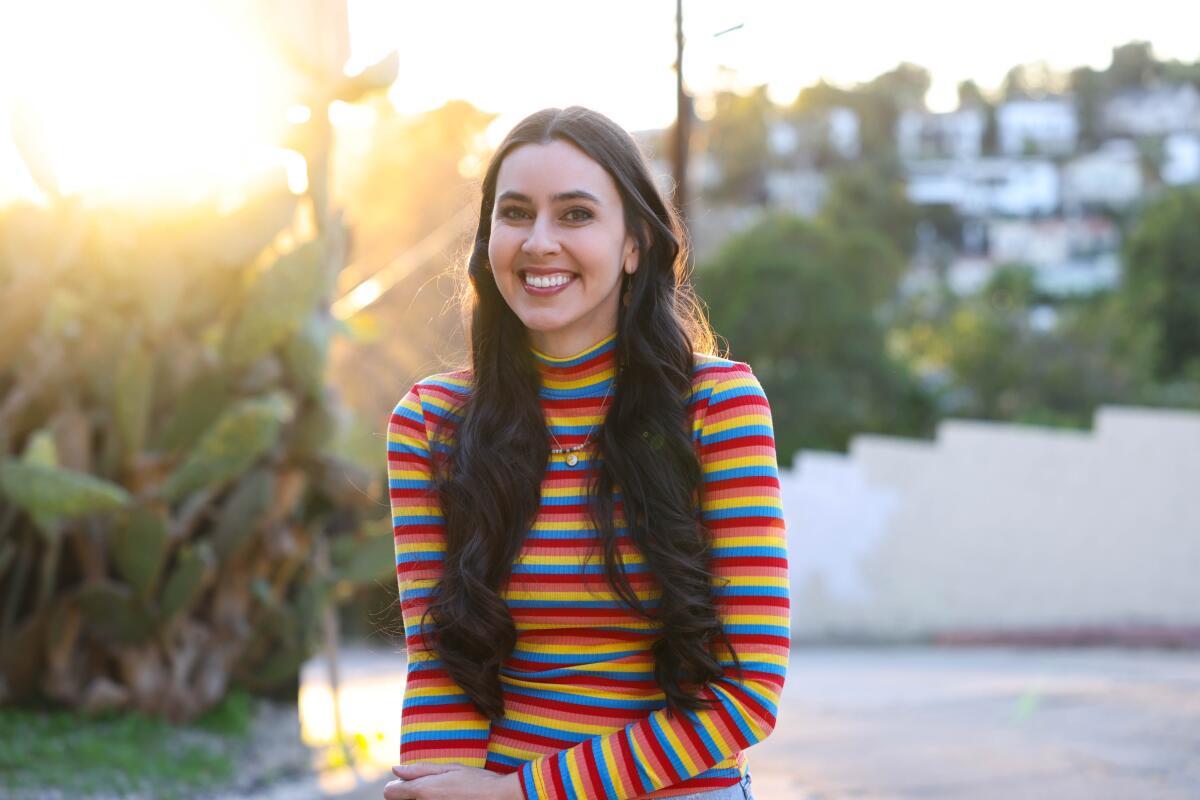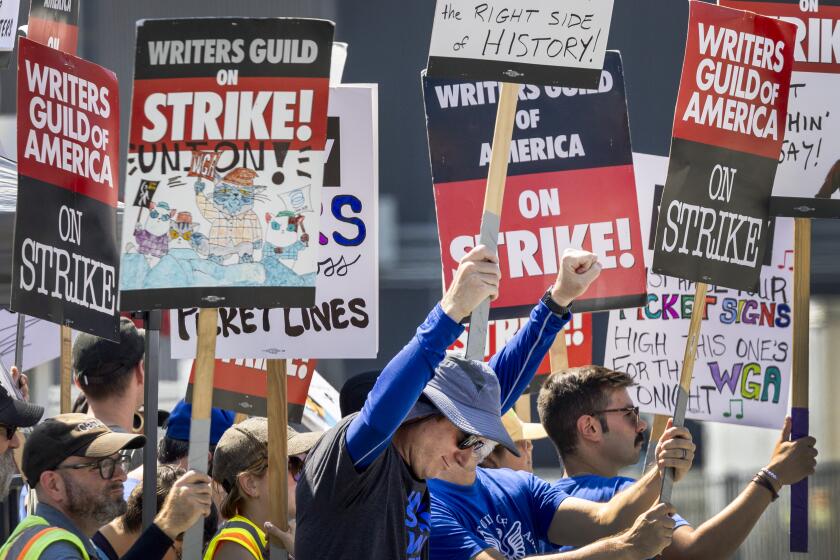Column: How L.A. really made the internet what it is

- Share via
The influencers have won. Digital media institutions are crumbling. We have pivoted to video. The internet of the 2020s is dominated by a handful of platforms — Instagram, TikTok, Spotify, YouTube — and the creators who rule them. Now even the mighty entertainment industry is in their thrall.
The story of how we got here is the subject of Taylor Lorenz’s compelling and expansive new book, “Extremely Online” — and it is, at heart, a story about the allure of fame, the desire to perform for a living, and how companies seeking to profit off of those base impulses encourage the hopeful to commoditize their personal experience.
It is, in other words, a story of Los Angeles.
“The entire content creator industry is based in L.A., and really emerged from L.A.,” Lorenz tells me. “Let’s not forget that the first platform that launched the influencer space was Myspace, and that was based in L.A.” It’s true! Myspace, the first globally dominant social media network, emerged not from Cupertino or Menlo Park or another bastion of Greater Silicon Valley but from a small subset of employees working for the marketing firm EUniverse in L.A.
A key thrust of Lorenz’s book is that the internet we know today was shaped as much by its most influential users — whom platforms both cater to and actively promote — as it was by the coders, founders and businesspeople who erected the digital infrastructure.
Medical device entrepreneur Joe Kiani is on a mission to stop Apple from crushing smaller competitors. His lawsuit could get the Apple Watch banned from being imported into the U.S.
When folks decry the current state of the web and how it’s dominated now by personality-driven content of the sort found on TikTok, Instagram, YouTube and Twitch, they typically point to algorithms that incentivize wild behavior and companies that emphasize engagement and profit over quality and public concern. That’s all pretty right on, at least from where I’m sitting.
But that narrative does leave out a key ingredient: the people who excel at offering up their wild behavior for public consumption — the people who create, as we might say in the 2020s, the engagement. And which city has the highest population density of eager and skilled performers per capita, perhaps in the world? L.A. It stands to reason, as Lorenz does, if engineers in the Bay Area hardwired the internet’s body, then Los Angeles is its beating heart.
“I spoke to content creators for this book that said that they felt like until they moved to L.A., they weren’t a real content creator,” she says. “I think that this is because, despite the fact that people think of the rise of social media as synonymous with Silicon Valley, as I argue in my book, these platforms are very heavily shaped by users, and specifically power users — content creators.”
And, she adds, “almost exclusively, those content creators have been in L.A.”
It’s a cliche as storied as the American Dream itself — setting out for Hollywood with a suitcase and aspirations of stardom — but it’s also an undeniable reality of how the local economy functions, and those dreamers are a latent and highly valuable resource for all those platforms, to put it in crass terms.
At a moment when the prospect of executives and managers using software automation to undermine work in professions everywhere loomed large, the WGA strike took on major symbolic weight.
Ever since Myspace Tom and his cohort founded that social network here, there’s been not only an active supply of talent but an increasingly sophisticated pipeline constructed to connect that talent to the Myspace of the moment.
In 2009, as Lorenz notes, the first so-called content house was established to accommodate full-time creators who made videos for platforms such as YouTube — the Station, in Venice Beach. Since then, as creators found success gathering followings, an array of talent agencies and independently owned media companies have sprung forth. This of course has been the most double-edged of swords, but Lorenz is keen to point out that the new landscape made room for a lot of voices that old media and legacy Hollywood studios were ignoring.
The rise of the influencer economy, she says, “has been a real positive force for a lot of marginal folks, like the beauty bloggers, catering to women of color who were ignored and maligned,” even though “a lot of people like to focus on the bad, the Jake Pauls.”

Regardless, despite being overshadowed by the major studies and goliath entrants like Netflix, L.A.’s influencer economy now stands to be worth half a trillion dollars in coming years, Lorenz says, citing a report from Goldman Sachs.
“People thought that the future of media would be BuzzFeed or Vox,” she says, “but the real future is being built in L.A. That’s where we see this robust ecosystem of creative talent using the internet to reshape Hollywood.”
“Movies live and die by TikTok now, not the other way around.”
Critics have knocked Lorenz’s book for being overly sympathetic to the influencers fighting their way to the top in this new ecosystem, but I’ve found the book to be rather agnostic in its approach — reporting on a new frontier of entertainment that may sound foreign to many, but that is an undeniable force in cultural and economic life. And in our chat, she’s plenty critical of the industry she covers, where the influence of its creative laborers far eclipses any protections and regulations.
A New York Times reporter who covers online culture is relocating to Los Angeles, and she needs your advice.
She talks about rampant burnout in the industry, as creators work around the clock to produce content for their fans — creators who, as in every industry, are overwhelmingly not as rich or successful as the paragons they get associated with. She talks about mental health issues among those who’ve become famous too fast, and scams that plague the influencer economy.
Worst of all, she talks about the lack of guardrails for creators, especially children. “There’s an enormous amount of child labor in this industry — and this was true of Hollywood, by the way — with kids as young as 13 creating content,” Lorenz says. She credits SAG-AFTRA for recognizing the emergent mode of media, and for its recent Influencer Agreement, which sought to institute protections and benefits for creators. “It’s how a bunch of content creators get healthcare.”
“People in East Coast media don’t understand how this business operates and they think of these people as taking selfies and making silly videos,” Lorenz says. “This is real creative labor. The Hollywood labor ecosystem was faster to recognize that.”
It often seems that more than a decade into its existence, few know what to make of the influencer economy, or where it fits in with the story of the internet at large. But we do need to know, as Lorenz adroitly maps out, that the story does not begin and end with Silicon Valley. It runs right through Hollywood.
- Share via
Watch L.A. Times Today at 7 p.m. on Spectrum News 1 on Channel 1 or live stream on the Spectrum News App. Palos Verdes Peninsula and Orange County viewers can watch on Cox Systems on channel 99.











